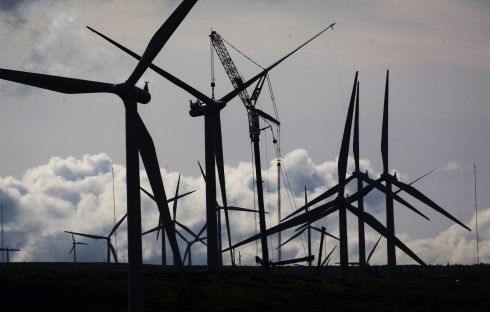Claire Doole visits a Córdoba olive farmer and finds he is doing his bit to combat global warming
As far as the eye can see, olive groves dot the hills of Andalucia. For centuries, the groves have supplied olives and olive oil – staples of Spanish cuisine – to restaurants and retailers. But over the past decade, olive growers have found a new market for their produce: the electricity sector.
Stretching across Spain’s southern-most tip, Andalucia is home to the world’s first olive power plant. In 1995, an electricity plant in the town of Palenciana on the Cordoba-Malaga border became a global pioneer in using olives as a source of renewable energy.
The plant turns olive residue into biomass — a type of fuel generated from animal waste and plant material such as wood and crops. This is then burnt to generate electricity and heat. The Palenciana plant currently produces enough green electricity for 27,000 households, and has since been joined by four others in the region.
Growing industry
José Santamaría is one of the pioneer green energy producers. His family has been growing and producing olives around Lucena for generations. But four years ago, he got on the biomass bandwagon.
“It seemed to us the ideal solution,” he explains. “We have always had the problem of what to do with the residue left over from making olive oil, which can contaminate soil and pollute the underground water system.
“By using it to produce green electricity, we have turned an environmental problem into an environmental solution.”
Santamaría started producing electricity along with oil in 2000. It started as a small-scale operation, providing enough to power 3,500 households in Lucena. But now he is expanding to use olive waste from neighbouring farms as well.
A combined oil and electricity plant is being built among the family olive groves. It is already a hive of activity. One after another, trucks line up to dump olives into a sunken storage container. The olives are then pressed and turned into oil. In a second building, the waste from the oil and olives is dried in massive revolving heaters to give olive biomass.
“We are just collecting the olive biomass at the moment,” explains Santamaría. “Over there,” he points at a clearing in front of the oil processing plant, “we are building the power plant where the biomass will be burnt to generate electricity.”
Production is expected to start in December. Santamaría hopes to generate enough electricity to power all of the households in Lucena, around 50,000 people.
Global warming
A well-dressed man in his 30s, Santamaría describes himself as an environmental businessman.
“Although,” he adds laughing, “it is more environmental than business at the moment. We are only just breaking even as the premiums paid by the electricity companies for each kilowatt from biomass are not exactly generous.”
However, he does have a ready market – all the electricity he produces is bought by local power supply companies and there is a market for increased production. And now that he has started making biomass, Santamaría is not going to give up. He thinks many of the region’s olive producers would do the same if the financial incentives were greater.
This would give greater benefits to the environment than simply disposing of polluting olive residue. Biomass is a renewable, CO2-neutral fuel making it a valuable technology in efforts to reduce CO2 emissions to curb global warming and climate change. “The big advantage biomass offers over renewable energy sources like wind and solar is it can be stored and used when needed. This means it can provide a constant, non-fluctuating supply of electricity,” says Heikki Willstedt, Energy and Climate Change Expert at the Spanish office of WWF, the global conservation group.
Many believe that, after wind power, biomass is the biggest renewable energy source that can be exploited on a large scale.
According to a report from WWF and the European Biomass Association, 15 per cent of electricity in OECD free market countries – enough to supply 100 million homes – could come from biomass by 2020. Compared to traditional power stations, this could cut CO2 emissions by about 1,000 million tonnes each year, an amount equivalent to the combined annual emissions of Canada and Italy.
With most industrialized countries struggling to meet commitments to reduce CO2 emissions, these figures should be a huge incentive to promote biomass along with other renewable energy sources. Spain, for example, agreed to limit emissions to a 15 per cent increase over 1990 levels by 2012 under the Kyoto Protocol.
However, the country is struggling to meet its target: CO2 emissions have already gone up by 40 per cent since 1990.
The biomass industry remains underdeveloped in most industrialized countries. It supplies just 3 per cent of Spain’s total electricity consumption, while in most industrialized countries the figure is only 1 per cent.
This is mainly due to lack of government support. For example, while Spanish biomass electricity producers receive a premium on top of the normal price for electricity, this premium is not high enough to make biomass attractive to most investors.
World leader
The industry is not without supporters. The director of the energy agency in Seville, Enrique Belloso Perez, is keen to promote biomass, along with other renewable energy sources like wind and solar power. He does concede, however, current laws on renewable energy are not cost effective to expand the use of biomass.
“We need a new more financially attractive law, which offers higher subsidies to producers. Otherwise there will be no new biomass plants built in Andalucia – or in Spain,” he says.
Willstedt agrees. “Biomass has a huge role to play in delivering clean, sustainable energy for the future. The technology is there – the stumbling blocks are political and commercial.”
Despite the problems, biomass has made an impressive beginning in Andalucia – already a world leader in wind and solar technology. Andalucia’s olive biomass power plants currently produce enough electricity for 130,000 households, while biomass as a whole supplies 5 per cent of the region’s total energy consumption.
And construction of Santamaría’s olive biomass power station continues.
“Of course, we started this project to make a profit,” says Santamaría. “But we know we are solving a serious problem at the same time. We feel happy earning money and helping the environment.”
The farmers in this part of the world, at least, are doing their bit.






